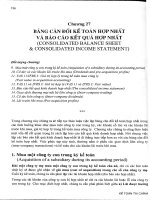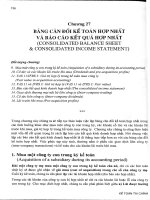Gíao trình kế toán bằng tiếng anh ch01
Bạn đang xem bản rút gọn của tài liệu. Xem và tải ngay bản đầy đủ của tài liệu tại đây (1.84 MB, 51 trang )
Chapter 1
Managerial
Accounting
Learning Objectives
After studying this chapter, you should be able to:
[1] Explain the distinguishing features of managerial accounting.
[2] Identify the three broad functions of management.
[3] Define the three classes of manufacturing costs.
[4] Distinguish between product and period costs.
[5] Explain the difference between a merchandising and a manufacturing income
statement.
[6] Indicate how cost of goods manufactured is determined.
1-1
Preview of Chapter 1
Managerial Accounting
Sixth Edition
Weygandt Kimmel Kieso
1-2
Managerial Accounting Basics
Managerial accounting is a field of accounting that
provides economic and financial information for managers
and other internal users.
Managerial accounting applies to all types of businesses.
1-3
Corporations
Partnerships
Proprietorships
Not-for-profit
Managerial Accounting Basics
Comparing Managerial and Financial
Accounting
1-4
Illustration 1-1
LO 1 Explain the distinguishing features of managerial accounting.
Managerial Accounting Basics
Review Question
Managerial accounting:
a. Is governed by generally accepted accounting
principles.
b. Places emphasis on special-purpose information.
c. Pertains to the entity as a whole and is highly
aggregated.
d. Is limited to cost data.
1-5
LO 1 Explain the distinguishing features of managerial accounting.
Managerial Accounting Basics
Management Functions
Planning
1-6
Directing
Maximize short-term
profit and market
share.
Commit to
environmental
protection and social
programs.
Add value to the
business.
Coordinate diverse
activities and human
resources.
Implement planned
objectives.
Provide incentives to
motivate employees
Hire and train
employees.
Produce smoothrunning operation.
Controlling
Keeping activities on
track.
Determine whether
goals are met.
Decide changes
needed to get back
on track.
May use an informal
or formal system of
evaluations.
LO 2 Identify the three broad functions of management.
1-7
Managerial Accounting Basics
Organizational Structure
Illustration 1-2
Organization charts show the
interrelationships of activities
and the delegation of authority
and responsibility within the
company.
1-8
LO 2 Identify the three broad functions of management.
Managerial Accounting Basics
Business Ethics
1-9
All employees are expected to act ethically.
Many organizations have codes of business ethics.
Past financial frauds:
►
Enron,
►
Global Crossing,
►
WorldCom
LO 2 Identify the three broad functions of management.
Managerial Accounting Basics
Business Ethics
Creating Proper Incentives
Systems and controls sometimes create incentives
for managers to take unethical actions.
1-10
Controls need to be effective and realistic.
LO 2 Identify the three broad functions of management.
Managerial Accounting Basics
Business Ethics
Code of Ethical Standards
Sarbanes-Oxley Act (SOX)
1-11
Clarifies management’s responsibilities.
Requires certifications by CEO and CFO.
Selection criteria for Board of Directors and Audit
Committee.
Substantially increased penalties for misconduct.
LO 2 Identify the three broad functions of management.
Managerial Accounting Basics
Review Question
The management of an organization performs several
broad functions. They are:
a. Planning, directing, and selling.
b. Directing, manufacturing, and controlling.
c. Planning, manufacturing, and controlling.
d. Planning, directing, and controlling.
1-12
LO 2 Identify the three broad functions of management.
Indicate whether the following statements are true or false.
False
1. Managerial accountants have a single role within an
organization, collecting and reporting costs to
management.
True
True
1-13
2. Financial accounting reports are general-purpose and
intended for external users.
3. Managerial accounting reports are special-purpose and
issued as frequently as needed.
LO 2 Identify the three broad functions of management.
Indicate whether the following statements are true or false.
False
4. Managers’ activities and responsibilities can be classified
into three broad functions: cost accounting, budgeting,
and internal control.
5. As a result of the Sarbanes-Oxley Act, managerial
False
accounting reports must now comply with generally
accepted accounting principles (GAAP).
True
1-14
6. Top managers must certify that a company maintains an
adequate system of internal controls.
LO 2 Identify the three broad functions of management.
Manufacturing Costs
Managers should ask questions such as the following.
1. What costs are involved in making a product or
providing a service?
2. If we decrease production volume, will costs decrease?
3. What impact will automation have on total costs?
4. How can we best control costs?
1-15
LO 3 Define the three classes of manufacturing costs.
Manufacturing Costs
Manufacturing Costs
Manufacturing consists of activities and processes that
convert raw materials into finished goods.
1-16
LO 3 Define the three classes of manufacturing costs.
Manufacturing Costs
Direct Materials
Raw Materials
Basic materials and parts used in
manufacturing process.
Direct Materials
Raw materials that can be physically and directly associated
with the finished product during the manufacturing process.
1-17
LO 3 Define the three classes of manufacturing costs.
Manufacturing Costs
Direct Materials
Indirect Materials
1-18
Not physically part of the finished product or they are
an insignificant part of finished product in terms of
cost.
Considered part of manufacturing overhead.
LO 3 Define the three classes of manufacturing costs.
Manufacturing Costs
Direct Labor
Work of factory employees that can be
physically and directly associated with
converting raw materials into finished
goods.
Indirect Labor
Work of factory employees that has no physical
association with the finished product or for which it is
impractical to trace costs to the goods produced.
1-19
LO 3 Define the three classes of manufacturing costs.
Manufacturing Costs
Manufacturing Overhead
Costs that are indirectly associated with manufacturing
the finished product.
Includes all manufacturing costs except direct materials
and direct labor.
Also called factory overhead, indirect manufacturing
costs, or burden.
1-20
LO 3 Define the three classes of manufacturing costs.
1-21
Manufacturing Costs
Review Question
Which of the following is not an element of manufacturing
overhead?
a. Sales manager’s salary.
b. Plant manager’s salary.
c. Factory repairman’s wages.
d. Product inspector’s salary.
1-22
LO 3 Define the three classes of manufacturing costs.
Product Versus Period Costs
Product Costs
Direct materials
Direct labor
Manufacturing overhead
Components:
Costs that are an integral part of producing the
product.
1-23
Recorded in “inventory” account.
Not an expense (COGS) until the goods are sold.
LO 4 Distinguish between product and period costs.
Product Versus Period Costs
Period Costs
1-24
Charged to expense as incurred.
Non-manufacturing costs.
Includes all selling and administrative expenses.
LO 4 Distinguish between product and period costs.
Product Versus Period Costs
Illustration 1-3
1-25
LO 4 Distinguish between product and period costs.









